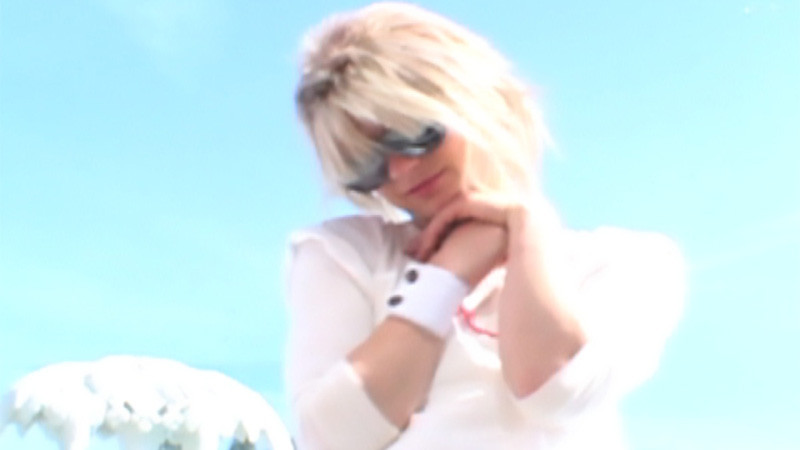You came to the JT LeRoy story in 2002, when you started to make a documentary about him. At that point, had you read the novels and what did you make of them?
I hadn’t read them. A friend had just moved to Los Angeles and he called me saying the photographer Kate Garner is looking for a documentary filmmaker, and do you want to start working on a project about this poet who lives in the Tenderloin? I jumped on the plane the next day and read The Heart is Deceitful Above All Things. At that point, John Waters, Tom Waits and Dennis Cooper were completely excited about JT. I jumped in. It was fun, and I had a good time hanging out with him. I felt a kinship. They seemed very San Francisco-in-Los Angeles. That was my superficial take. At that point I worked on the film for 10 months, doing five or six shoots.
When you started filming, JT was being played by Savannah Knoop, and Laura Albert and her partner Geoffrey Knoop were posing as JT’s confidants and housemates Speedie and Astor. Did you have any inkling about what was going on?
It all seemed strange, and they acted strange. In hindsight, people said Savannah had no Adam’s apple, but I absolutely thought there was a JT who wrote those books. From that first shoot in L.A. to the shoot in Napa, the question for me was that I didn’t know if I liked where he was going. JT seemed to be turning into this diva asshole.
As the story came out that LeRoy didn’t exist, what was your reaction?
Just the audacity to do it, that’s why it’s so astounding. Laura was the only one making the phone calls and emails. Savannah was hired for those occasions. At first I thought that JT definitely existed and Laura ghostwrote the books. Stephen Beachy basically had to deprogram me. I was blown away by his analysis of the situation from the get-go. He’s really brilliant. I just generally try to see the good in people, and this topic has been really challenging.
The footage from Dr. Terrence Owens’s deposition is the most conspicuous thread running through the film. Can you talk a little bit about what he was being deposed for, and his relationship with JT and Laura?
That was a deposition from the film company’s fraud lawsuit. Dr. Owens always did phone therapy with JT. He was duped like every other person, and just as shocked. But after that he continues to treat her as Laura. And Laura thinks that her therapeutic needs are so great it justifies everything.
You don’t get into your relationship with Laura Albert, or your attempts to interview her.
I decided not to make it about us, because that would be a limitation. It’s a much bigger story. About six months after Stephen Beachy’s story came out, she called me back after my attempt to interview her, and it started friendly enough. “How are you doing? How is your baby?” Then she started screaming and raging at me in this intense way, threatening to sue me if I made the film. “You’re an opportunist,” she said. “You’re going to kiss your kid’s college education goodbye.” I said, “Laura, you’re acting like you and me had this open and honest relationship.” And she said, “Oh, so you’re going to play that card.” This is what she does, and it works. Most people aren’t used to being on the receiving end of so much vitriol. I’ve worked with gang members and felons and the mentally ill, and I’ve never crossed paths with something like this.
You end the film with a title card saying that Laura Albert hasn’t published any books under her own name, but she’s had a fairly visible post-JT career, working in fashion, serving on the jury for film festivals. What do you make of that?
I think it really shows the power of a con artist, a cult leader, to twist and warp reality through charisma and lies. I think the story is confusing enough that I give some people the benefit of the doubt that they don’t fully understand the facts about it all. And some people prefer a good story to the facts. I don’t doubt that the people who Laura is ensnaring now are empathetic sorts who think she is a victim somehow. That is who con artists go after. I think we want to believe that we live in some sort of civilization, and it’s quite disconcerting that our world is as predatory as it is. We don’t expect this from artists. We expect this from Wall Street and wars. The other element is the curiosity factor. Laura has branded herself a celebrity by association with JT, who managed to get close to celebrities. Sadly enough, for some that is extremely exciting.
Often, discussions about the hoax center on Laura Albert’s right to use a pseudonym, but I think your film establishes that’s the least interesting question about this case.
The pseudonym thing is a weird red herring that she used in the fraud trial. The work was always presented as autobiographical fiction. The first thing Laura Albert wrote as JT was a memoir published under the name “Terminator” in Laurie Stone’s Close to the Bone anthology. The problem is that everyone interviews her and she just lies and lies. They go to her as a source for the story. The meta story is the relentless spinning and how the media gets it so wrong again and again. Like she keeps saying she never said JT was HIV positive, and she did numerous times.
Toward the end of the film, several people address whether or not JT LeRoy’s work can stand on its own. What do you think?


